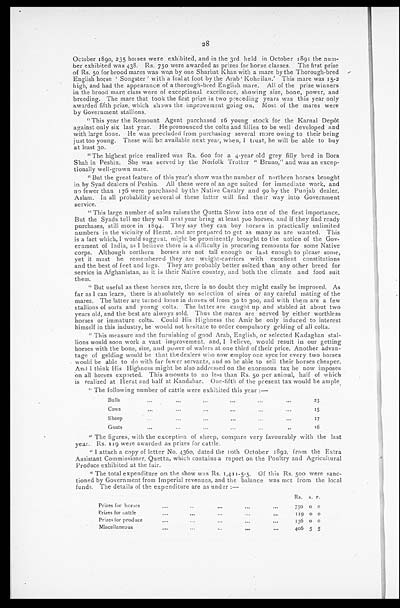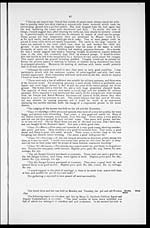Medicine - Veterinary > Civil Veterinary Departments > 1892-1893 - Report on the metropolitan horse fairs and district horse shows of 1892-93 > 1892-1893 - Report on the metropolitan horse fairs and district horse shows of 1892-93
(32) Page 28
Download files
Individual page:
Thumbnail gallery: Grid view | List view

28
October 1890, 235 horses were exhibited, and in the 3rd held in October 1891 the num-
ber exhibited was 438. Rs. 750 were awarded as prizes for horse classes. The first prize
of Rs. 50 for brood mares was won by one Sharbat Khan with a mare by the Thorough-bred
English horse 'Songster' with a foal at foot by the Arab 'Koheilan.' This mare was 15-2
high, and had the appearance of a thorough-bred English mare. All of the prize winners
in the brood mare class were of exceptional excellence, showing size, bone, power, and
breeding. The mare that took the first prize in two preceding years was this year only
awarded fifth prize, which shows the improvement going on. Most of the mares were
by Government stallions.
"This year the Remount Agent purchased 16 young stock for the Karnal Depôt
against only six last year. He pronounced the colts and fillies to be well developed and
with large bone. He was precluded from purchasing several more owing to their being
just too young. These will be available next year, when, I trust, he will be able to buy
at least 30.
"The highest price realized was Rs. 600 for a 4-year old grey filly bred in Bora
Shah in Peshin. She was served by the Norfolk Trotter "Bruno," and was an excep-
tionally well-grown mare.
"But the great feature, of this year's show was the number of northern horses brought
in by Syad dealers of Peshin. All these were of an age suited for immediate work, and
no fewer than 176 were purchased by the Native Cavalry and 90 by the Punjab dealer,
Aslam. In all probability several of these latter will find their way into Government
service.
"This large number of sales raises the Quetta Show into one of the first importance.
But the Syads tell me they will next year bring at least 700 horses, and if they find ready
purchases, still more in 1894. They say they can buy horses in practically unlimited
numbers in the vicinity of Herat, and are prepared to get as many as are wanted. This
is a fact which, I would suggest, might be prominently brought to the notice of the Gov-
ernment of India, as I believe there is a difficulty in procuring remounts for some Native
corps. Although northern horses are not tall enough or fast enough to please some,
yet it must be remembered they are weight-carriers with excellent constitutions
and the best of feet and legs. They are probably better suited than any other breed for
service in Afghanistan, as it is their Native country, and both the climate and food suit
them.
"But useful as these horses are, there is no doubt they might easily be improved. As
far as I can learn, there is absolutely no selection of sires or any careful mating of the
mares. The latter are turned loose in droves of from 30 to 300, and with them are a few
stallions of sorts and young colts. The latter are caught up and stabled at about two
years old, and the best are always sold. Thus the mares are served by either worthless
horses or immature colts. Could His Highness the Amir be only induced to interest
himself in this industry, he would not hesitate to order compulsory gelding of all colts.
"This measure and the furnishing of good Arab, English, or selected Kadaghan stal-
lions would soon work a vast improvement, and, I believe, would result in our getting
horses with the bone, size, and power of walers at one third of their price. Another advan-
tage of gelding would be that the dealers who now employ one syce for every two horses
would be able to do with far fewer servants, and so be able to sell their horses cheaper.
And I think His Highness might be also addressed on the enormous tax he now imposes
on all horses exported. This amounts to no less than Rs. 50 per animal, half of which
is realized at Herat and half at Kandahar. One-fifth of the present tax would be ample
" The following number of cattle were exhibited this year:—
|
Bulls |
... |
... |
... |
... |
... |
... |
23 |
|
Cows |
... |
... |
... |
... |
... |
... |
15 |
|
Sheep |
... |
... |
... |
... |
... |
... |
17 |
|
Goats |
... |
... |
... |
... |
... |
.. |
16 |
"The figures, with the exception of sheep, compare very favourably with the last
year. Rs. 119 were awarded as prizes for cattle.
"I attach a copy of letter No. 4360, dated the 10th October 1892, from the Extra
Assistant Commissioner, Quetta, which contains a report on the Poultry and Agricultural
Produce exhibited at the fair.
"The total expenditure on the show was Rs. 1,411-5-5. Of this Rs. 500 were sanc-
tioned by Government from Imperial revenues, and the balance was met from the local
funds. The details of the expenditure are as under:—
|
Rs. |
A. |
p. |
||||||
|
Prizes for horses |
... |
... |
... |
... |
... |
750 |
0 |
0 |
|
Prizes for cattle |
... |
... |
... |
... |
... |
119 |
0 |
0 |
|
Prizes for produce |
... |
... |
... |
... |
... |
136 |
0 |
0 |
|
Miscellaneous |
.... |
... |
... |
... |
... |
406 |
5 |
5 |
Set display mode to: Large image | Zoom image | Transcription
Images and transcriptions on this page, including medium image downloads, may be used under the Creative Commons Attribution 4.0 International Licence unless otherwise stated. ![]()
| Permanent URL | https://digital.nls.uk/75518306 |
|---|




